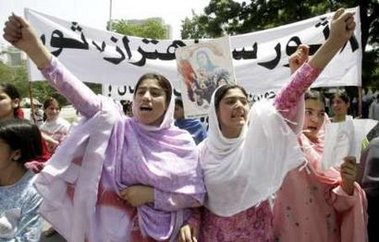M WAQAR..... "A man's ethical behavior should be based effectually on sympathy, education, and social ties; no religious basis is necessary.Man would indeed be in a poor way if he had to be restrained by fear of punishment and hope of reward after death." --Albert Einstein !!! NEWS,ARTICLES,EDITORIALS,MUSIC... Ze chi pe mayeen yum da agha pukhtunistan de.....(Liberal,Progressive,Secular World.)''Secularism is not against religion; it is the message of humanity.'' تل ده وی پثتونستآن
Sunday, March 27, 2011
Afghan women are still at risk
Sima is 15 but looks younger. I met her in Kabul, in the female juveniles section of the Badam Bagh prison. She talks very little, but her eyes are full of grief. A defence lawyer told me it was likely she had been raped.
What is Sima's crime? She is serving her sentence for running away from domestic violence. About half of all women in Afghan prisons are there for the same "crime". Some of them are in prison with their babies. The youngest ones are no older than 12. Having spent time in jail, they will rarely be accepted back by their families and communities.
Ten years since the Taliban fled Kabul, while new laws, policies and development aid have brought some benefits to Afghan women, deep-rooted challenges remain. The Office of the United Nations High Commissioner for Human Rights recently issued a report on harmful traditional practices against women and girls in Afghanistan. About half of women get married before the age of 15. It is estimated that 70-80% of marriages are forced. Selling girls or giving them away in settlement of a conflict is common practice. The literacy rate of Afghan girls of 15 or more is just 12%. Unsurprisingly, violence and abusive behaviour against them is widespread.
Afghanistan has ratified the convention on the elimination of discrimination against women, but its initial report is long overdue. A law on elimination of violence against women has been adopted recently, but its enforcement is a real challenge: victims are reluctant to seek help from police officers, 99% of whom are male.
So, what can they do when they face abuse? Desperate girls and women all too often commit suicide, an increasing number of them by self-immolation. Those who have the courage to run away and seek refuge within their family are often returned to their abusive husbands or parents. The ones who try to find a safe haven at their neighbours' or friends' houses face criminal charges for the intent to commit zina (adultery, or sexual relations out of marriage). The punishment is not provided by law – nor, I was told by experts, is it consistent with sharia, which requires witnesses and proof. It is based merely on an instruction of the supreme court of Afghanistan. The only safe haven for victims are NGO-run shelters for women and girls, yet Afghan authorities have recently threatened their continued operation.
I visited the oldest shelter in Afghanistan and talked to the girls and women under its protection. It was heartbreaking to hear their pleas for the maintenance of the shelters, as they are the only places they can go: "If this place is closed, I have no option then to kill myself", a young women told me. I raised the issue with President Karzai, who assured me that the number of shelters would not be reduced and that he was in favour of government financially supporting NGO-run shelters.
The UN security council has adopted a resolution extending the mandate of the UN assistance mission in Afghanistan. It "strongly condemns" continuing discrimination against women and girls; calls for enhanced efforts to secure their rights; and supports women's shelters. It also addresses the main problem: empowerment of Afghan women and ensuring that women's rights are an integral part of peace, reintegration and reconciliation efforts. If girls are not educated and women not included in political life, public administration and the justice system, traditional harmful practices will continue and their human rights will never be protected. Only if they are present and active in peace talks can they rest assured that even the modest gains secured to date will not be used as bargaining chips.
For peace to be sustainable and just, both Taliban and women should sit at the negotiating table and be included in shaping decisions on the future of Afghanistan.
Subscribe to:
Post Comments (Atom)

No comments:
Post a Comment